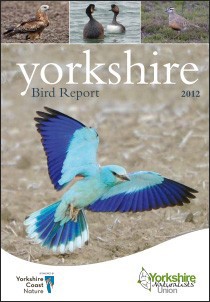Yorkshire Bird Report 2012

I sat as a passenger on a four-hour road journey and decided to make the 2012 report my main reading. I was quickly drawn in by the absorbing content. Indeed, I found it inspiring and on a personal note found my spirit rising to get involved in more field ornithology and as a contributor to the biological record. The report is beautifully illustrated, beginning with the front cover and Rebecca Nason's photograph of a beetle-hunting Roller. Illustrations by both locally and nationally recognised artists such as Ray Scally, Colin Wilkinson, Darren Woodhead and Ian Lewington thoroughly enliven the publication. Throughout the body of text, the reader's attention is maintained by small comment boxes with interesting nuggets of information, such as "the dark peak wader survey located 185 pairs of Lapwing", and "an estimated 21 breeding pairs of Grey Wagtail were present in the Sheffield area". A gallery of photos towards the end has some stunning images (I especially liked Andy Deighton's juvenile Long-tailed Skua) followed by some local reviews: an account by Mark Thomas of his patch birding journey at Buckton and a fulsome read on Firecrests breeding in the Sheffield area by Richard Hill. A table of early and late migrant dates gives a challenge to observers to improve on them, and a full list of ringing recoveries throughout the county ends in a beautiful two-page map showing some of the more interesting wide-flung journeys which the birds have made. An extra flap at the back contains a map of Yorkshire, with the four county recorders and a place to tuck in your own personal notes. Craig Thomas and his team of 14 writers are to be thoroughly congratulated on this tour de force.
For the future, this work needs to be more widely read. In today's world of instant news and short pithy headlines, my only concern was that such a good avifauna is not sufficiently de rigeur to reach its deserved wide audience. As I read it, it got me thinking that perhaps two or three levels of this kind of report could be produced, including a digital format; perhaps a short pithy headline form which would appeal to a wider audience, and a more fulsome addition as here. Whichever, this is an exemplar of report writing that sets a very high bar and a useful benchmark for other counties.
Published by the Yorkshire Naturalists' Union, colour photographs. £12.00 plus £2.00 p&p. Available from Jill Warwick jill@swland.co.uk 01765 602 832; cheques to be made payable to Yorkshire Naturalists' Union.
Yorkshire Naturalists' Union website


